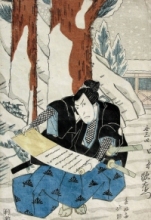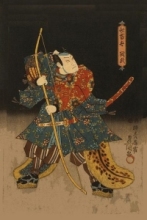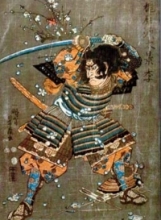Articles
Bujinkan Dojo Code

by Toda Shinryuken Masamitsu, Meiji 23 (1890)
- Know patience comes first.
- Know the path of Man comes from justice.
- Renounce avarice, indolence, and obstinacy.
- Recognize sadness as natural and seek the immovable heart.
- Follow the path of loyalty and benevolence; delve into the heart of Budo by pursuing a balance of literary and martial arts.
Ninjutsu Hiketsu Bun

By Takamatsu Toshitsugu
The essence of all martial arts and military strategies is self-protection and the prevention of danger. Ninjutsu epitomizes the fullest concept of self-protection of not only the physical body, but the mind and spirit as well. The way of the ninja is the way of enduring, surviving, and prevailing over all that would destroy one. More than merely delivering strikes and slashes, and deeper in significance than the simple out-witting of an enemy; ninjutsu is the way of attaining that which we need while making the world a better place. The skill of the ninja is the art of winning.
In the beginning study of any combative martial art, proper motivation is crucial. Without the proper frame of mind, continuous exposure to fighting techniques can lead to ruin instead of self-development. But this fact is not different from any other beneficial practice in life carried to extremes. Medical science is dedicated to the betterment of health and the relief of suffering, and yet the misuse of drugs and the exultation of the physician's skills can lead people to a state where an individual's health is no longer within his or her personal control. A nutritious well-balanced diet works to keep a person alive, vital, and healthy, but grossly over-eating, over-drinking, or taking in too many chemicals is a sure way to poison the body. Governments are established to oversee the harmonious interworking of all parts of society, but when the rulers become greedy, hungry for power, or lacking in wisdom, the country is subjected to needless wars, disorder, or civil and economic chaos. A religion, when based on faith developed through experience, a broad and questing mind, and an unflagging pursuit of universal understanding, is of inspiration and comfort to people. Once a religion loses its original focus, however, it becomes a deadly thing with which to deceive, control, and tax the people through the manipulation of their beliefs and fears. It is the same with the martial arts. The skills of self-protection, which should provide a feeling of inner peace and security for the marial artist, so often develop without a balance in the personality and lead the lesser martial artist into warped realms of unceasing conflict and competition which eventually consume him.
If an expert in the fighting arts sincerely pursues the essence of ninjutsu, devoid of the influence of the ego's desires, the student will progressively come to realize the ultimate secret for becoming invincible - the attainment of the 'mind and eyes of the divine.' The combatant who would win must be in harmony with the scheme of totality, and must be guided by an intuitive knowledge of the playing out of fate. In tune with the providence of heaven and the impartial justice of nature, and following a clear and pure heart full of trust in the inevitable, the ninja captures the insight that will guide him successfully into battle when he must conquer and conceal himself protectively from hostility when he must acquiesce. The vast universe, beautiful in its coldly impersonal totality, contains all that we call good and bad, all the answers for all the paradoxes we see around us. By opening his eyes and his mind, the ninja can responsively follow the subtle seasons and reasons of heaven, changing just as change is necessary, adapting always, so that in the end there is no such thing as surprise for the ninja.
Annual Themes

By Joe Maurantonio
Showa 57 (1982) - Masaaki Hatsumi first travels to West (to Dayton, Ohio, USA) to teach Budo.
Showa 58 (1983) - Yumoa Mura, Japan was the site of the very first Tai Kai.
Showa 61 (1986) - Received the "Best Instructor Award" from the Black Belt Magazine (as voted by the readers). First Bujinkan related video released. First foreign Taikai: USA. [First USA Tai Kai had a focus on basic kihon happo, taihenjutsu and kusari fundo.]
Showa 62 (1987) - First travel to Europe (London, UK) to teach Budo. Taikai in: United Kingdom and USA.
Showa 63 (1988) - Acted in Jiraya, a 50 episodes children's adventure series made by Asahi Television. Played the part of "Yamaji Tetsuzan" (Jiraya's father and teacher). Taikai in: USA, UK, and Sweden.
Heisei 1 (1989) - Taikai in: USA, UK, Sweden, and Israel.
Heisei 2 (1990) - He was the "Chairman of the International Division, Japan Literary Artist's Club" 1990-94. Taikai in: USA, UK, Sweden, and Spain.
Heisei 3 (1991) - Received a letter of appreciation from US President George Bush on his 60th birthday. Honorary Member of Texas Rangers. Theme of the year is Jutte and Kenjutsu. Taikai in: USA, UK, Sweden, Spain, and Germany.
Heisei 4 (1992) - Honorary degree of Ph.D. Natural Science from a U.S. University. Received the Cross Medal and Sun Medal from Juan Carlos, King of Spain. Accepted the position as the Director of the Japan Literary Club, International Section. Taikai in: USA, UK, Sweden, Spain, Germany, Australia, Luxembourg, Portugal, and Israel.
Heisei 5 (1993) - Main Theme this year was Rokushaku Bojutsu & Taijutsu. Taikai in: USA, Spain, Australia, France, and Argentina.
Heisei 6 (1994) - Main Theme this year was Sojutsu (Yari) & Kodachi. Became "Knight" at Frankfurt. Taikai in: UK, Germany, and USA.
Heisei 7 (1995) - Main Theme this year was Naginatajutsu & Daisho Sabaki Gata & Taijutsu. Renamed ninjutsu to budo taijutsu to reflect the growth of training available to students. Was awarded the title Todo Hanshi (Master teacher of the way of the sword) by Nakazawa Toshi, President of Zen Nippon Todo Renmei (Sword Federation). Honorary Member of Arizona Rangers. Received Letters of thanks from FBI. Taikai in UK, New Zealand, Spain, and USA.
Heisei 8 (1996) - Main Theme this year was Bikenjutsu & Taijutsu. Opened the Bujinden (honbu dojo) September 9th. Taikai in: Holland, Spain, and USA.
Heisei 9 (1997) - Main Theme this year was Jojutsu, Tachi and Taijutsu. Taikai in: Spain and USA.
Heisei 10 (1998) - Main Theme this year was Shindenfudo-ryu Dakentaijutsu Happo Biken. Taikai in: Italy, Sweden, and USA.
Heisei 11 (1999) - Main Theme this year was Kukishin-ryu Taijutsu Happo Biken. Received the Grand Prize from International Cultural Promoting Association, signed by the Japanese Emperor. Taikai in: Germany, UK, and USA.
Heisei 12 (2000) - Year of Tatsu-Kanoe (Dragon-Metal) - Main Theme this year was Koppojutsu. In November, Hatsumi Sensei receives "Cultural Award". Taikai in: Holland and USA.
Heisei 13 (2001) - Main Theme this year was Kosshijutsu. In May, receives Papal recognition. Taikai in: Spain and USA.
Heisei 14 (2002) - Main Theme this year is Takagi Yoshin Ryu Jujutsu and the formal wear of the year is Hakama. Taikai in: Norway and USA.
Heisei 15 (2003) - Main Theme this year is Juppou-sesshou, Kunai, Ninja-tou, Tessen, Kyoketsushoge. Taikai in England and USA. Officially, the final year that Hatsumi Sensei does Taikai overseas.
Heisei 16 (2004) - Main Theme this year is Roppo Kuji no Biken Budo no Kiso. Special Taikai held in Japan. Emphasis placed on Yugen no Sekai (world of the unmanifested)
Heisei 17 (2005) - Main Theme this year is Gyokko-ryu Happo Biken, Bo and Ken with an emphasis on Kasumi no Ho (encompassing mist).
Heisei 18 (2006) - Main Theme this year is Shinden Fudo Ryu while wearing armor.
Heisei 19 (2007) - Main Theme this year is Kukishin Ryu with an emphasis on Kuki Taisho (nine smiling demons).
Heisei 20 (2008) - Main Theme this year is Togakure-ryu Ninpo Taijutsu with an emphasis on Kieru no Kankaku (feeling of disappearing).
Heisei 21 (2009) - Main Theme this year is Mu (no theme) but later emerged a focus of Sainou (ability), Tamashii (spirit) and Utsuwa (capacity) [which can alternately be pronounced Sainou-Kon-Ki]. Emphasis was placed on nawa no kankaku (the feeling of rope).
Heisei 22 (2010) - Main Theme this year is Rokkon Shoujou (influencing the spirit through laughter) with an emphasis on the Tachi.
Heisei 23 (2011) - Main Theme this year is Kihon Happo (changing seasons, beginning growth) with an emphasis on developing our foundation.
Heisei 24 (2012) - Main Theme this year is Futsu (burning away) with an emphasis on kaname (essential point) and "ken" (can be fists, weapons, swords, etc)
Heisei 25 (2013) - Theme this year is Tachi Hoken (divine treasure sword).
Heisei 26 (2014) - Theme this year is Shin Gin Bu Do.
Heisei 27 (2015) - Theme this year is Gokou Goshin.
Heisei 28 (2016) - Theme this year is Muto Dori and Tobi ishi.
Heisei 29 (2017) - Theme this year is Kannin Doshi.
Heisei 30 (2018) - Theme this year is Muto Dori.
Heisei 31/Reiwa 1 (2019) - Theme this year is Muto Dori. Hatsumi-Sensei awards the Soke title to several of his Japanese students.
Reiwa 2 (2020) - Soke retires officially. In March, Honbu Dojo closes due to the global pandemic.
Reiwa 3 (2021) - Honbu Dojo remains closed. Hatsumi-soke celebrates his 90th birthday.
Reiwa 4 (2022) - Honbu Dojo remains closed.
Reiwa 5 (2023) - Honbu Dojo re-opens.
Reiwa 6 (2024) - Many Tai Kai happening around the world.
Ranking Structure

By Masaaki Hatsumi
Training Begins With Taijutsu
Kyu levels: beginners
Shodan to Yondan: Ten (heaven)
Godan to Judans: Chi (earth)
Ju-ichidan to Ju-Godan dans: Jin (person)
The eleventh to fifteenth dans are broken into Chi (earth), Sui (water), Ka (fire), Fu (wind) and Ku (the void); the Happo Hiken will be taught at these levels. The fifth dan test shall only be administered by Soke. True shihan can be given fifteenth dan.
Recently, the Bujinkan has become truly international. Just as there are various time zones, so exist various taboos among the world's peoples and nations. We must respect each other, striving to avoid such taboos. We must put the heart of the warrior first, working together for self-improvement and for the betterment of the Bujinkan.
Communication with the Hombu must be in Japanese. This is to help all business run smoothly now that the Bujinkan has become international.
Those not upholding the above-mentioned guidelines shall be forced out of the Bujinkan.
Rules of the Bujinkan

By Masaaki Hatsumi
The Bujinkan shall be open to only those who agree with and uphold the guidelines of the Bujinkan Dojo. Those not doing so shall not be allowed to join.
Specifically:
Only those who have read and agreed with these guidelines shall be allowed to participate.
Only those able to exercise true patience, self-control, and dedication shall be allowed to participate.
A physician's examination report shall be required. Specifically, individuals with mental illness, drug addiction, or mentally instability shall be barred from joining. The necessity of such a report concerns individuals who may present a danger to others, for example, those with infectious diseases or illnesses, individuals with clinically abnormal personalities or physiology, and individuals lacking self-control.
Individuals with criminal records shall be turned away. Trouble makers, those who commit crimes, and those living in Japan who break domestic laws shall be turned away.
Those not upholding the guidelines of the Bujinkan, either as practitioners or as members of society, by committing disgraceful or reproachable acts shall be expelled. Until now, the Bujinkan was open to large numbers of people who came to Japan. Among them, unfortunately, were those committing violent drunken acts, the mentally ill, and trouble makers who thought only of themselves and failed to see how their actions might adversely affect others. Through their actions, such people were discarding the traditional righteous heart of the Bujinkan. From this day forward, all such people shall be expelled.
Regarding accidents occurring during training (both inside and outside the dojo), one should not cause trouble to the Bujinkan. This is an extremely important point. Those unwilling to take personal responsibility for accidents occurring during Bujinkan training shall not be admitted. Reiterating for clarity, the Bujinkan shall not take responsibility for any accidents happening in the course of training, regardless of the location.
All those joining the Bujinkan must get an annual member's card. This card not only preserves the honor of the Bujinkan members, it indicates you are part of a larger whole -- one whose members come together with warrior hearts to better themselves through training and friendship. It evinces the glory of warrior virtue, and embodies both loyalty and brotherly love.
All members must have a membership card for the year, issued by the Hombu. There are two types of membership card: General Membership Card and Shidoshi Kai Membership Card:
(i) The General Membership Card applies to members of the Bujinkan Dojo, whether ungraded, kyu-grade or dan-grade.
(ii) The Shidoshi Kai Membership Card applies to those of Fifth Dan and above (called Shidoshi), and those from First to Fourth Dan (called Shidoshi-ho). Members who are teaching should posess one of these cards. Non-Shidoshi Kai members are not recognized as teachers and cannot grade students.
All memberships must be renewed every year.
Membership of the Shidoshi Kai of Fifth Dan and above may apply to the Hombu for licenses up to Fourth Dan, and may award these to their students. Members over Fifth Dan are promoted personally by Soke, who will judge them on their technique, character and integrity. (Update: As of 2002, Hatsumi Sensei has given direct permission to certain individuals to administer the godan test.)
Only membership cards and licenses issued by the Bujinkan Dojo Hombu will be recognized as valid. People issueing "fake" membership cards and/or certificates will face expulsion from the Bujinkan Dojo.
The "Bujin" symbol is copywright. If planning to use it, you must contact the Hombu first for permission.
The tradition of the Bujinkan recognizes nature and the universality of all human life, and is aware of that which flows naturally between the two parts:
"The secret principle of Taijutsu is to know the foundations of peace.
To study is the path to the immovable heart (fudoshin)."
Bunbu Ryodo

By Joe Maurantonio
Last year, a friend of mine remarked on how impressed he was with the high level of martial arts skill of our dojo members. Naturally, I thanked him for his observation. He also added he was further impressed by the fact many of the students at our dojo pursued their education in university settings as well.
"Balance," we smiled.
My dictionary explains the meaning of the word balance as "a stable mental or psychological state; emotional stability." One of the more important aspects of our martial training deals with the concept of life balance. Bunbu Ryodo, or the balance of pen and sword, is derived from the the Edo period of Japan. During this period, the Tokugawa Shogunate encouraged the members of its warrior class to pursue both the literary and martial arts with equal emphasis. It was an attitude that helped the bushi adjust from the warring period of Japan to one of peace. And today it helps those who pursue the martial ways develop into complete human beings.
